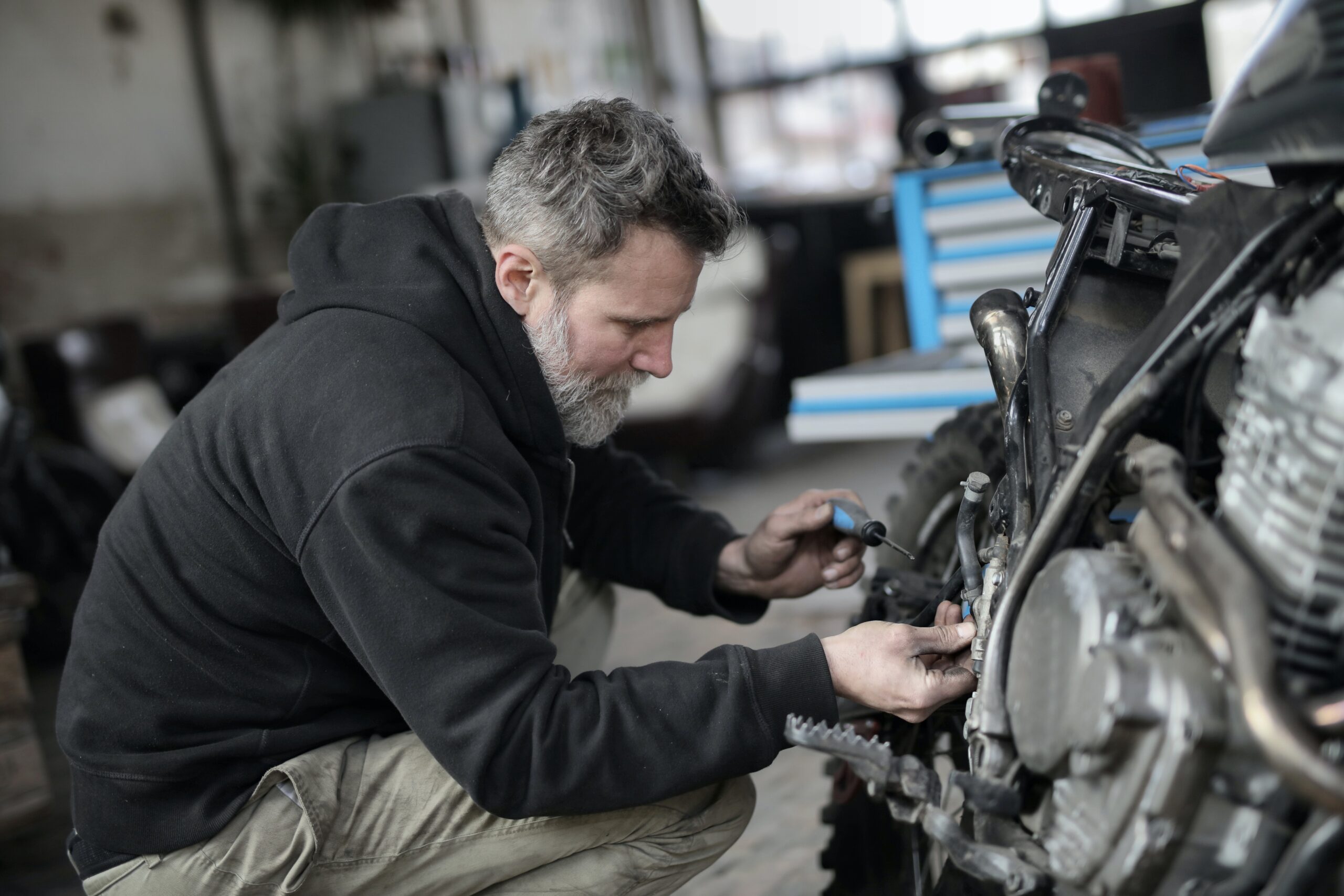Background
Tools are used in a variety of circumstances for a variety of purposes. This is why it is critical to choose the right tool for your needs. A ratchet screwdriver is a popular piece of equipment. It’s been around for decades and is commonly used as an electrical repair tool for electronics such as laptops and cell phones, but that’s not all it can accomplish.
The ratchet mechanism makes it simple to drive screws into tight spaces. It is also really simple to use. Simply spin the handle in the direction you want the screw to go. This saves time and work while also guaranteeing that your job is completed as soon as possible.
However, you may be unaware of the long-running debate between ratchet and non-ratchet mechanisms. While non-ratchets are often thought to be of higher quality, this does not mean they will not break while in use.
History
A ratchet screwdriver includes a mechanism that allows it to impart turning force in one direction while freely moving in the opposite. As a result, it can be programmed to drive or remove screws without requiring the bit to be moved in and out of the screw head at the end of each revolution. This speeds up and improves the ease of driving or removing screws and other threaded fasteners.
In the early 20th century, a German inventor named Conrad Baumann invented a ratcheting screwdriver, branded Baumann-Weltrecord, with a fold-out handle to provide extra torque.
Baumann was a toolmaker by trade, but he was also an inventor, holding patents on a variety of screwdrivers.
Baumann’s brand apparently lasted for almost ten years.
The narrative doesn’t end there; in 1950, a German patent was filed with the US Patent and Trademark Office under the same tool, defining the identical details of a ratcheting screwdriver, and is the first written record of the ratcheting screwdriver comprising replaceable bits with a separate driving handle.
Following this, Baumann filed two more patents, one in 1959 that officially links his 1950s patent to his original DRGM mark, which would have been lost. Another, much more complex and polished version that took advantage of the newest technical skills of the time, the addition of a molded plastic handle, smaller mechanics, and reduced overall size, paired with a collet-style chuck, was published in 1967. However, it is still designed to only work with the supplied bits.
Features of the Ratchet Screwdriver
1. Well-Made Gearing
A ratchet screwdriver is made up of two parts: the handle and the gear. To produce a strong coupling between the handle and the gear, the helical gears are composed of alloy steel.
2. Comfortable Handle
A nice ratchet screwdriver has a comfortable handle that wraps around one side of the tool. While working on infrequent repairs, the friction design and ergonomic handle allow you to easily secure your hardwood screw. Furthermore, the ratchet screwdriver has a rubber soft-grip handle that makes it comfortable to hold.
3. Robust Ratchet Mechanism
A ratchet mechanism ensures fluid and quick rotation in good ratchet screwdrivers. The ratcheting mechanism also keeps your screwdriver in place, allowing you to easily attach and unfasten screws.
Ratcheting Screwdriver Buying Guide
1. The Type of Bit
The ratcheting screw’s flexibility is determined by the type of bit and its capacity. The conventional single-bit screwdriver design was basic yet limited. The screw size varies depending on the application. Every time the screw size changes, you’ll need a different size of single-bit screwdriver. Because of the interchangeable bit, multi-bit screwdrivers provide greater versatility. Their bits can be changed as the screw size changes. Multi-bit screwdrivers also allow you to store more sizes of bits for later use.
2. The Ratcheting Mechanism
The ratcheting mechanism is essential for the “screwing” action. It aids in the application of the required torque to the screw, which in turn delivers the digging force to the screw threads. To allow one-way rotation of the screwdriver, a pawl and gear are employed. The ratcheting mechanism comes in a variety of configurations. Some variants enable only one direction of rotation, which is perfect for standard screws.
Both the left and right-handed screws revolve in opposite directions. As a result, a bi-directional ratcheting mechanism allows rotation in both the clockwise and counterclockwise directions. The ratcheting screw has a switch for changing the rotation direction or locking the ratcheting mechanism.
3. Shank Length
A screwdriver comes in a variety of shank lengths. This length is critical in transferring torque to a screw. The screwdriver’s twisting moment is uniformly delivered to the tip via the shank’s length. It aids in optimizing input with restricted screwdriver movement. A shorter shank is advantageous for tiny screws because it transfers torque more easily. The shorter shanks are unable to retain a firm grip. The shank length can be increased for narrow areas. It aids in accessing these tight locations while maintaining a wide field of view. For certain users, one-handed operating with a greater shank length can be stressful.
4. Tip Type
Like a jigsaw puzzle, the tip of a screwdriver fits with the screw. The form of the tip and screw become entangled, allowing force to be transferred from the screwdriver to the screw thread. The flat-headed tips are the most prevalent. They come in handy for straight screws. The Phillips tip is designed for cross-shaped Philips screws. These tips provide excellent torque to the screw and improve overall grip. The Phillips tips were updated to a Star shaped tip, which increases gripping power even more. The ratchet screwdrivers come with squared-off Robertson tips and various precision tips.
Difference Between Ratchet and Non-Ratchet Screwdrivers
There are numerous distinctions between ratchet and non-ratchet screwdrivers. One of the most noticeable variances is its design, which was created to serve diverse functions. Non-ratchet drivers have two coils and can spin faster than other types of drivers. Here are some distinctions between ratchet and non-ratchet screwdrivers:
1. Ratchet screwdrivers are easier to use and have better gear.
2. Non-ratchet screwdrivers can shatter, although they are typically thought to be of higher quality.
3. Non-ratchet screwdrivers can carry up to six bits, whereas ratchets typically hold three.
4. Non-ratchet screws require higher torque and are difficult to keep from slipping.
5. Ratchets do not have to be any heavier than non-ratchets.
6. Stainless steel ratchet screwdrivers are more efficient, but this has no effect on their strength when compared to non-ratchet screwdrivers manufactured of less expensive materials.
7. Ratchets can be run dry without ever malfunctioning.
Why Should We Use the Ratchet Screwdriver?
1. Comfort
Because the ratchet screwdriver is similar to a wrench, it can be softer with less force and easily displace heavy objects. Furthermore, the ratchet screwdriver is the most efficient and powerful tool in its class.
2. Efficiency
A ratchet screwdriver, like an electric drill, allows you to change direction very quickly. This is useful because when changing the way a screw goes into something, it will substantially assist in ensuring that nothing slides out because it has less irritating torque than non-ratchets and no additional bits, resulting in only six pieces in comparison to three in most non-ratchets.
3. Control
Using ratchet precision screwdrivers can help you achieve better control because changing the direction of screws is easy without risking fumbling. Non-ratchets, on the other hand, might make it difficult to change the direction of screws without risking dropping them.
4. Power
Ratchet screwdrivers are more powerful than non-ratchets and may be ran dry without ever breaking down, allowing you to accomplish more work. Non-ratchets are not as powerful as ratchets; therefore, you will need to replace them frequently if you require a lot of force.
Pros of a ratcheting screwdriver:
Work Faster with a Ratchet Screwdriver
The ratcheting screwdriver’s claim to fame is that it allows you to work faster. If you’re conducting a time-consuming task that requires inserting a lot of screws, the ratcheting set can help.
Many individuals don’t realize that when using a conventional screwdriver, you have to change your grip frequently, even if you’re going fast. Our hands aren’t designed to swivel.
The ratchet allows you to keep a solid grasp and pressure on the screw while turning it. Another advantage of consistency is that you are less likely to lose the screw. When driving a screw by hand, we frequently have to keep recentering the screwdriver. You are less likely to disengage from the screw with a ratchet screwdriver, resulting in a speedier job.
Fewer Lost Screws with Ratchet Screwdriver
You’ll proceed faster since you won’t have to reposition the screwdriver, and you won’t have to worry about losing the screw when you readjust the bit. The screw will frequently come out with the bit. The bit may be magnetized on purpose, but this will work against you if it readily dislodges the screw.
Furthermore, as we’ll see in the following section, ratchet screwdrivers frequently allow you to change the bit, ensuring a good fit and resulting in fewer lost and stripped screws.
Ratchet Screwdrivers Give You More Options
Most ratcheting screwdrivers work in the same way as a multi-tool does. They normally come with a set of bits that, like a powered drill, can be placed into the end of the screwdriver. This can be really useful for individuals who enjoy this configuration.
For one thing, you can save a lot of space. Instead of carrying a variety of screwdrivers of various sizes, you could only carry one. This video displays an interchangeable screwdriver.
For two, if you’re in the middle of a project, you won’t have to hunt through a toolbox to find a lower bit size — it’s there on the screwdriver.
Ratcheting screwdrivers frequently allow you to store bits in the handle, which is really useful. This is normally a bonus for most individuals, but we’ll discuss why this interchangeability can be problematic in later parts.
Works for Small Bolts
A ratcheting screwdriver can also double as a wrench for extra small bolts. Usually, you can find extra small bolt drivers that will fit on a ratcheting screwdriver, this makes it convenient if you run across a project that needs more precision than a regular socket set.
Up until now, we’ve been singing the praises of the ratcheting screwdriver, but these tools are not without their downsides.
Cons of a Ratcheting Screwdriver
The ratcheting screwdriver is an excellent tool, but it is not without flaws. In fact, some people may despise these tools since they are a little gimmicky. We’re going to talk about it all.
At the end of the day, you’ll have to test them out to see if a ratcheting screwdriver will work for you.
Some Ratcheting Screwdrivers are Low Quality
The problem with ratcheting screwdrivers is that they are really cool, which means that a lot of knockoffs or low-quality tools are marketed. These tools are frequently sold as “dad gifts” or inexpensive toolbox items.
This flood of low-quality ratcheting screwdrivers on the market reduces their total perceived value and increases the likelihood that someone looking to acquire one may come across something of poor quality.
The trick is to look for a ratcheting screwdriver with a good reputation – read internet reviews. And, if possible, go to the store and hold them in your hand before purchasing. Simply handling them will give you a good sense of their quality.
Good Ratcheting Screwdrivers are more Expensive than Regular Screwdrivers
Because good ratcheting screwdrivers are more expensive than regular screwdrivers, some people may discount their worth. If you’re going to spend the money on a ratcheting screwdriver, you need think about a few things.
First and foremost, what types of projects are you working on? If you frequently use a hand screwdriver, a ratcheting screwdriver could be quite useful.
Second, do you already have a well-organized collection of screwdrivers? If you do, a ratcheting screwdriver may not be as useful to you.
It’s Easy to Lose a Ratcheting Screwdriver Bit
Another common problem, particularly for individuals who aren’t naturally organized, is losing the bits to the ratcheting screwdriver. Often, especially when purchasing a low-cost ratcheting screwdriver, the bit housing is shallow, allowing the bits to fall out.
In this situation, you might find yourself reaching for a screwdriver only to discover that it lacks a bit. This is infuriating.
To alleviate this problem, tape spare bits to the side of the ratcheting screwdriver. If you only need a permanent Philips or flathead ratchet screwdriver, you might be able to obtain a ratcheting screwdriver with a permanent bit.
Some Ratcheting Screwdrivers are Confusing
Ratcheting screwdrivers can be frustrating for some people. When you grab them, make sure they’re pointed in the right direction before using them; otherwise, you’ll either spin the screw in the wrong direction or not spin it at all.
Some people may prefer the ease of use of a conventional screwdriver, without having to worry about how the screwdriver is positioned. The good news is that a ratcheting screwdriver can usually be placed to a neutral position and used just like a standard screwdriver.
Should You Buy a Ratcheting Screwdriver?
If you have the money, you’ll be glad you bought a ratcheting screwdriver. However, you will discover that it does not completely replace the simplicity of a standard screwdriver.
The ratcheting screwdriver will assist you to work more quickly, particularly if you have any repetitive screws to remove by hand. You will have fewer screw-loss incidents and will be able to carry more screw bits.
However, the ratcheting screwdriver is more expensive than a regular screwdriver, and while it is useful, it also has drawbacks. Ratcheting screwdrivers can be difficult to use. Not only that, but the components are easily lost, and you must be wary of knockoffs.
Conclusion
It can be inferred that ratchet screwdrivers are more advantageous than less technologically developed non-ratchet screwdrivers. The reason for this is that the equipment is referred to as “gear” and “gears.”
Ratchet screwdrivers include mechanical gears, which makes them well-built, attractive, and usable in terms of flexibility and responsiveness to what you’re doing. As a result, they outperform DIY low-quality screwdrivers without gears, which are notorious for being rather delicate.


